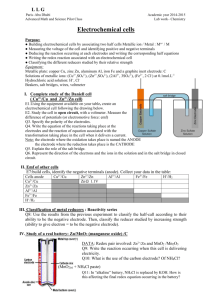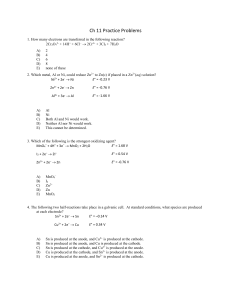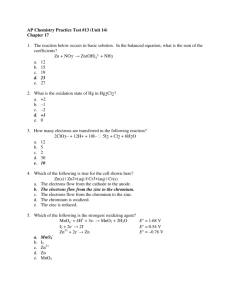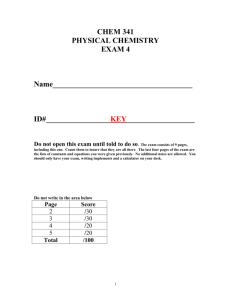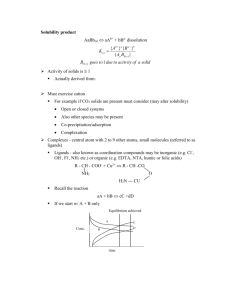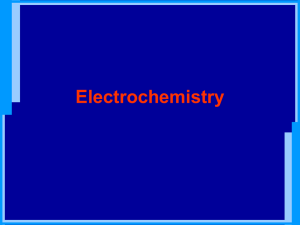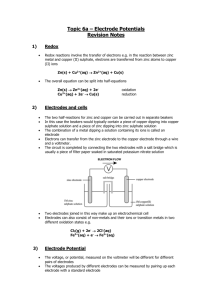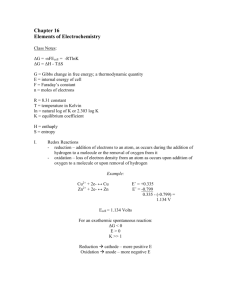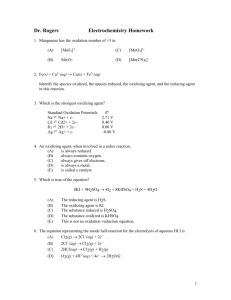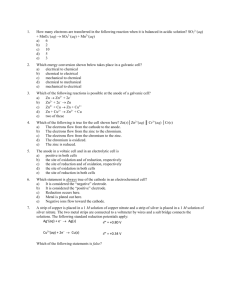AP Chemistry Chapter 17 Practice Test: Electrochemistry
advertisement
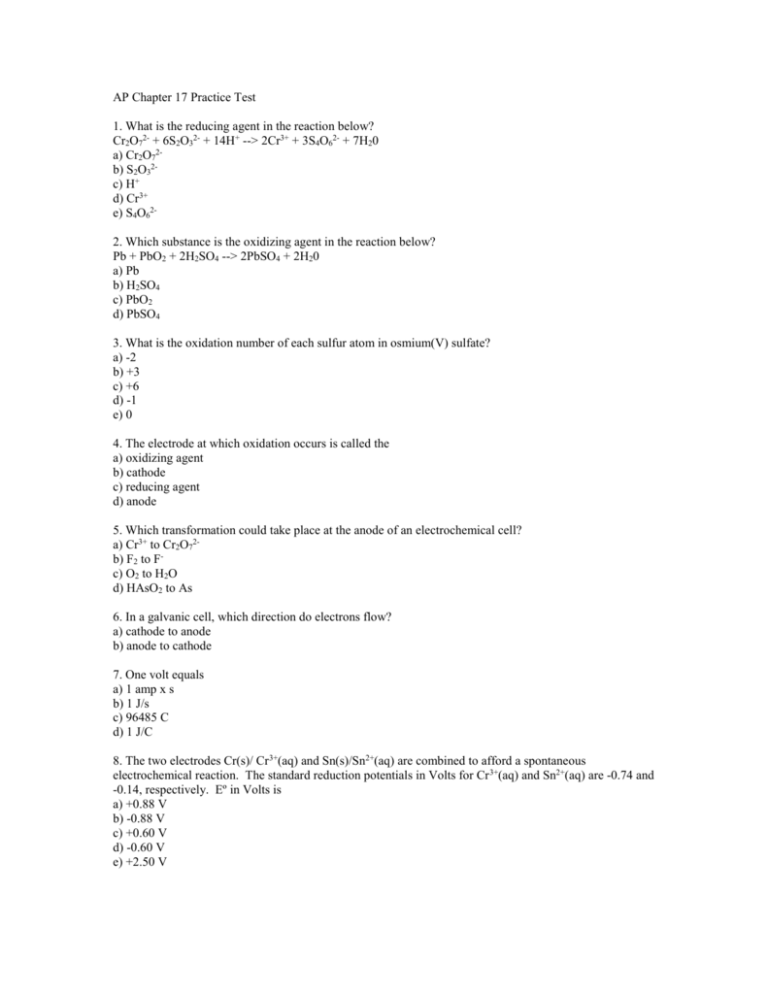
AP Chapter 17 Practice Test 1. What is the reducing agent in the reaction below? Cr2O72- + 6S2O32- + 14H+ --> 2Cr3+ + 3S4O62- + 7H20 a) Cr2O72b) S2O32c) H+ d) Cr3+ e) S4O622. Which substance is the oxidizing agent in the reaction below? Pb + PbO2 + 2H2SO4 --> 2PbSO4 + 2H20 a) Pb b) H2SO4 c) PbO2 d) PbSO4 3. What is the oxidation number of each sulfur atom in osmium(V) sulfate? a) -2 b) +3 c) +6 d) -1 e) 0 4. The electrode at which oxidation occurs is called the a) oxidizing agent b) cathode c) reducing agent d) anode 5. Which transformation could take place at the anode of an electrochemical cell? a) Cr3+ to Cr2O72b) F2 to Fc) O2 to H2O d) HAsO2 to As 6. In a galvanic cell, which direction do electrons flow? a) cathode to anode b) anode to cathode 7. One volt equals a) 1 amp x s b) 1 J/s c) 96485 C d) 1 J/C 8. The two electrodes Cr(s)/ Cr3+(aq) and Sn(s)/Sn2+(aq) are combined to afford a spontaneous electrochemical reaction. The standard reduction potentials in Volts for Cr 3+(aq) and Sn2+(aq) are -0.74 and -0.14, respectively. Eº in Volts is a) +0.88 V b) -0.88 V c) +0.60 V d) -0.60 V e) +2.50 V 9. The standard reduction potentials in Volts for Ag + and Ni2+ are +0.80 and -0.28, respectively. Electrons in the cells flow through the _______ toward the ________. a) wire, silver electrode b) wire, nickel electrode c) salt bridge, nickel electrode d) salt bridge, silver electrode 10. The standard reduction potentials in Volts for Pb 2+ and Ag+ are -0.13 and +0.80, respectively. Calculate Eº ( in volts) for a cell in which the overall reaction in Pb + 2Ag + --> Pb2+ + 2Ag. a) 0.93 b) 0.67 c) 1.73 d) 1.47 11. Which of the following types of elements is most likely to be good oxidizing agents? a) alkali metals b) lanthanides c) alkaline earth elements d) transition metals e) halogens 12. Which one of the following is not a good reducing agent? a) H2 b) Na c) O2 d) Li e) Ca 13. Use the following standard reduction potentials in V: I2 + 2e- -->2I-, +0.54; Br2 + 2e- --> 2Br-, +1.07; 2H+ + 2e --> H2, 0.00; Cu2+ + 2e- --> Cu, +0.34; Ni2+ + 2e --> Ni, -0.28. Which one of the following species could be used to oxidize I - to I2? a) Br2 b) H+ c) Cu2+ d) Ni2+ 14. Calculate the delta Gº for the reaction of elemental bromine with chloride ion. The Eº for the reduction of Br2 to bromide ion is 1.09V and the Eº for the reduction of Cl 2 to chloride ion is 1.36V. a) 2.10 x 105 J b) -2.62 X 105 J c) 0.27 J d) 5.21 x 104 J 15. A spontaneous electrochemical reaction has a) delta Gº = 0, Eº = 0 and K>>1 b) delta Gº < 0, Eº > 0 and K>1 c) delta Gº > 0, Eº < 0 and K<1 d) delta Gº > 0, Eº < 0 and K>1 e) delta Gº < 0, Eº = 0 and K>>1 16. Eº for the following reaction is 0.13 V. What is the value of Δ Gº (in kJ) for the reaction? Pb(s) + 2H+(aq) --> Pb2+(aq )+ H2(g) a) -25 b) 25 c) -12 d) 12 17. Consider the half reaction below. What will happen to the voltage of the half cell if the iodate concentration (IO3-) is increased? 2IO3-(aq) + 10e- + 12H+(aq) --> I2(s) + 6H2O(l) Eº = 1.195V a) it will increase b) it will decrease c) it will not change 18. The standard reduction potentials in volts, for Ag+ to Ag and Fe3+ to Fe2+ are +0.80 and +0.77 respectively. Calculate K, the equilibrium constant, for the following reaction at 25ºC. (R = 8.3145 J/K*mole) Ag+(aq) + Fe2+(aq) --> Ag(s) + Fe3+(aq) a) 10.0 b) 2.0 c) 3.2 d) 1.0 19. Consider the galvanic cell with a balanced equation of 2Cr(s) + 3Cu 2+(aq) --> 2Cr3+(aq) + 3Cu(s) Eº = 0.43V. What is the voltage of this cell when [Cu2+] = 1.0M and [Cr3+] = 0.010M? a) 1.2V b) 0.87V c) 0.47V d) 0.39V 20. Zn(s) + Cu2+(aq) <--> Zn2+(aq) + Cu(s) A galvanic cell based on the reaction above was constructed from zinc and copper half-cells. The observed voltage was found to be 1.00 volt instead of the standard cell potential, Eº, of 1.10 volts. Which of the following could correctly account for this observation? a) The copper electrode was larger than the zinc electrode. b) The Zn2+ electrolyte was Zn(NO3)2, while the Cu2+ electrolyte was CuSO4. c) The Zn2+ solution was more concentrated than the Cu2+ solution. d) The solutions in the half-cells had different volumes. e) The Cu2+ solution was more concentrated than the Zn2+ solution. 21. A cell is set up with copper and lead electrodes in contact with CuSO 4(aq) and Pb(NO3)2(aq), respectively, at 25ºC. The standard reduction potentials are Pb2+ + 2e- --> Pb Eº = -0.13V Cu2+ + 2e- --> Cu Eº = +0.34V If sulfuric acid is added to the Pb(NO3)2 solution, forming a precipitate of PbSO4, the cell potential a) increases b) decreases c) is unchanged d) can't tell what will happen 22. Which of the following statements is/are TRUE? 1. Aluminum is protected from corrosion by the formation of an aluminum oxide coating on the surface. 2. Iron is protected from corrosion by the formation of an iron oxide coating on the surface. 3.Cathodic protection of iron uses a metal that is more easily reduced than iron. 4. Cathodic protection of iron uses a metal that is more easily oxidized than iron. a) 1 and 3 b) 1 and 4 c) 2 and 3 d) 2 and 4 e) 1, 2, and 3 23. Consider the following electrochemical reactions: Zn2+ + 2e- --> Zn Eº = -0.76V Cu2+ + 2e- --> Cu Eº = 0.34V The solution is electrolyzed for 1.00 hour at a current of 3.00 amp. Which of the following statements is then TRUE? a) The Cu electrode will be 3.56 g heavier b) The Cu electrode will be 3.56 g lighter c) The Cu electrode will be7.12 g heavier d) The Zn electrode will be 3.66 g lighter e) The Zn electrode will be 7.32 g heavier 24. How long will it take to plate out 2.19 g of chromium metal from a solution of Cr3+ using a current of 35.2 amps? a) 5.77 minutes b) 346 minutes c) 115 minutes d) 1.92 minutes 25. What current is required to plate out 1.22 g of nickel from a solution of Ni 2+ in 1.0 hour? a) 65.4 amps b) 4010 amps c) 1.17 amps d) 12.9 amps 26. How many grams of Ca metal could be produced by the electrolysis of molten CaBr 2 using a current of 30.0 amp for 10.0 hours? a) 22.4 g b) 448 g c) 0.0622 g d) 224 g ----------Key---------1. (b) 2. (c) 3. (c) 4. (d) 5. (a) 6. (b) 7. (d) 8. (c) 9. (a) 10. (a) 11. (e) 12. (c) 13. (a) 14. (d) 15. (b) 16. (a) 17. (a) 18. (c) 19. (c) 20. (c) 21. (a) 22. (b) 23. (b) 24. (a) 25. (c) 26. (d)
